《英语教学法教程》课件—15
- 格式:ppt
- 大小:330.00 KB
- 文档页数:8
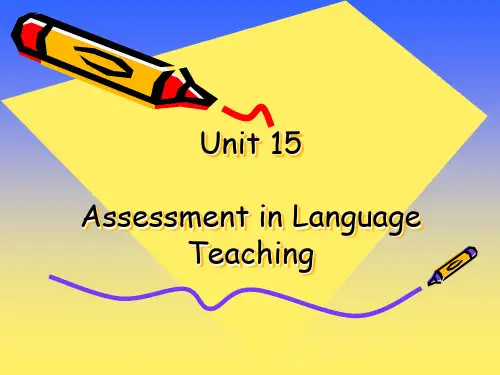
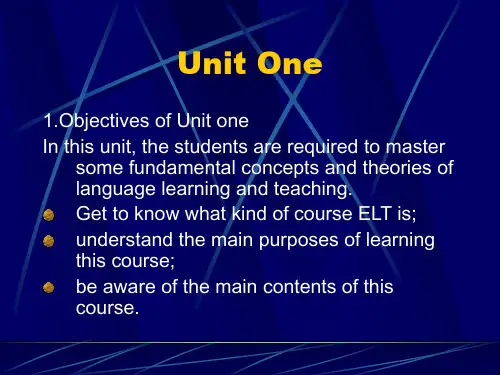
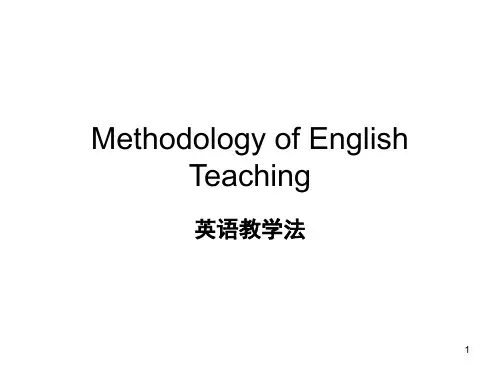
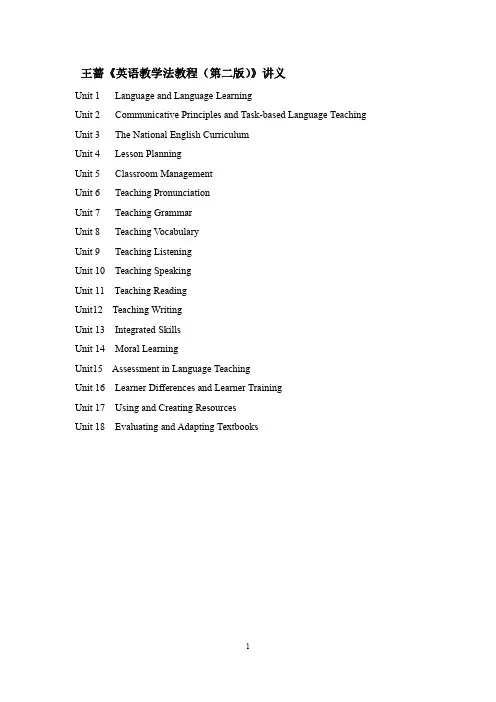
王蔷《英语教学法教程(第二版)》讲义Unit1Language and Language LearningUnit2Communicative Principles and Task-based Language Teaching Unit3The National English CurriculumUnit4Lesson PlanningUnit5Classroom ManagementUnit6Teaching PronunciationUnit7Teaching GrammarUnit8Teaching VocabularyUnit9Teaching ListeningUnit10Teaching SpeakingUnit11Teaching ReadingUnit12Teaching WritingUnit13Integrated SkillsUnit14Moral LearningUnit15Assessment in Language TeachingUnit16Learner Differences and Learner TrainingUnit17Using and Creating ResourcesUnit18Evaluating and Adapting Textbooks语言和语言学习【考情分析】本章主要讨论语言观和语言学习观、优秀教师的基本素养以及如何成为一名优秀的英语教师。
主要考点:结构主义、功能主义和交互语言理论;行为主义、认知主义、建构主义和社会建构主义学习理论;一个好的语言老师必备的素养;教师专业技能发展等。
【知识框架】Unit1 Language and Language Learning Views on languageViews in generalA good language teacherFunctional viewBehaviourist theoryCognitive theoryConstructivist theorySocio-constructivist theoryInteractional viewHow can one becomea good language teacher?An overview of the bookethic devotionprofessional qualitiespersonal stylesStage1Language trainingStage2Learning,practiceand reflectionGoal语言和语言学习1.1How do we learn languages?We learn language at different agesPeople have different experiencesPeople learn languages for different reasonsPeople learn languages in different waysPeople have different understandingsPeople have different capabilities in language learningLearning can be affected by the way how language is taughtLearning is affected by the degree of success one is expect to achieve.Thus the challenge confronting language teaching is how teaching methodology can ensure successful learning by all the learners who have more differences than the commonality.1.2Views on languageIn the past century,language teaching and learning practice has been influenced by three different views of language,namely,the structural view,the functional view and the interactional view.(1)The structural view of language结构主义语言观The structural view of language sees language as a linguistic system made up of various subsystem(Larsen-Freeman&Long,1991):the sound system(phonology音系学);the discrete units of meanings produced by sound combinations(morphology形态学/词汇学),and the system of combining units of meaning for communication (syntax句法学).Each language has a finite number of such structural items.结构主义语言观:结构主义语言观将语言看作由许多子系统组成的语言学系统(Larsen-Freeman&Long,1991):语音系统(音系学);产生于语音集合的意义的离散单位(形态学),以及交际意义的集合单元系统(句法学)。
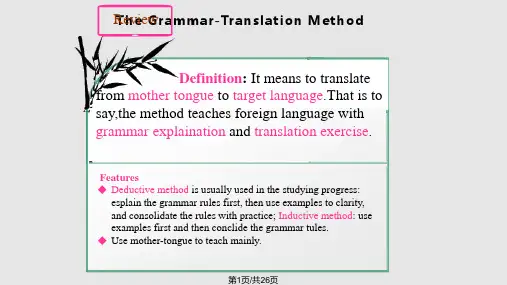
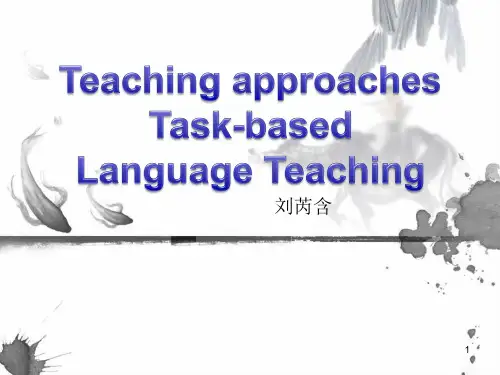
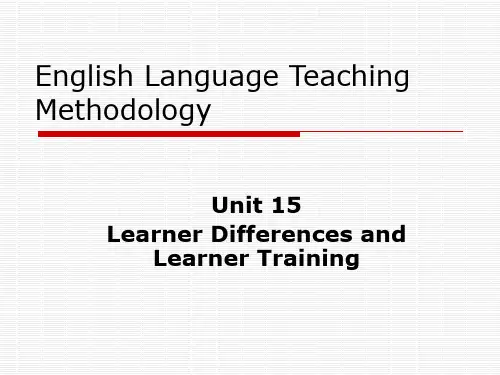
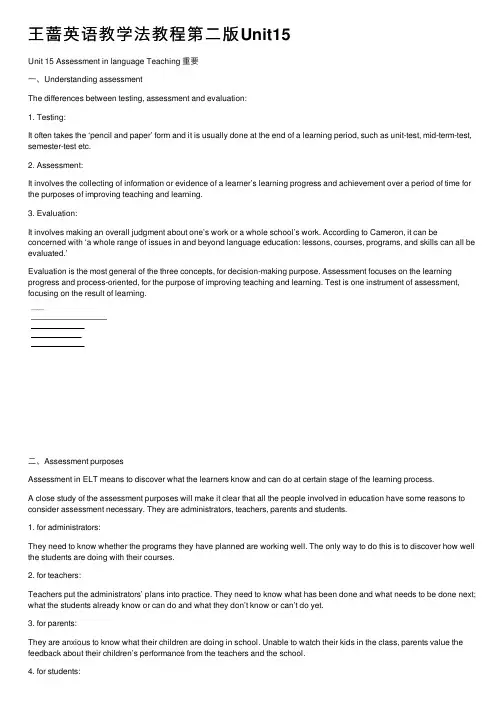
王蔷英语教学法教程第⼆版Unit15Unit 15 Assessment in language Teaching 重要⼀、Understanding assessmentThe differences between testing, assessment and evaluation:1. Testing:It often takes the ‘pencil and paper’ form and it is usually done at the end of a learning period, such as unit-test, mid-term-test, semester-test etc.2. Assessment:It involves the collecting of information or evidence of a learner’s learning progress and achievement over a period of time for the purposes of improving teaching and learning.3. Evaluation:It involves making an overall judgment about one’s work or a whole school’s work. According to Cameron, it can be concerned with ‘a whole range of issues in and beyond language education: lessons, courses, programs, and skills can all be evaluated.’Evaluation is the most general of the three concepts, for decision-making purpose. Assessment focuses on the learning progress and process-oriented, for the purpose of improving teaching and learning. Test is one instrument of assessment, focusing on the result of learning.⼆、Assessment purposesAssessment in ELT means to discover what the learners know and can do at certain stage of the learning process.A close study of the assessment purposes will make it clear that all the people involved in education have some reasons to consider assessment necessary. They are administrators, teachers, parents and students.1. for administrators:They need to know whether the programs they have planned are working well. The only way to do this is to discover how well the students are doing with their courses.2. for teachers:Teachers put the administrators’ plans into practice. They need to know what has been done and what needs to be done next; what the students already know or can do and what they don’t know or can’t do yet.3. for parents:They are anxious to know what their children are doing in school. Unable to watch their kids in the class, parents value the feedback about their children’s performance from the teachers and the school.4. for students:They need to know what they’ve accomplished, be aware of what they need to work on next, and build up confidence and satisfaction from what they have achieved.三、Methods for assessmentAssessment includes testing but definitely not only testing. Assessment is often divided into summative assessment and formative assessment.1. Summative assessment:Summative assessment is mainly based on testing. It is done mostly at the end of a learning period or the end ofa school year.2. Formative assessment:Formative assessment is based on information collected in the classroom during the teaching process for the purposes of improving teaching and learning, therefore, it is sometimes termed as classroom assessment as well.3. The ways to gather students’ learning information:(1)Teacher’s observationsTeacher’s observations of the learners’ overall performance or achievement can be quite accurate and fair.(2)Continuous assessmentThe final grade given to the student is some kind of combination of the grades the student has received for various assignments during the course.(3)Self-assessment and peer assessmentStudents are able to make quite accurate assessment of their own achievements. With peer-assessment students are involved in assessing each other’s work.(4)Project workProject work requires students to complete a set of tasks designed to explore a certain idea or concept.(5)PortfoliosA portfolio is a purposeful collection of materials assembled over a period of time by a learner to provide evidence of skills, abilities and attitudes related to their study.四、Criteria for assessmentAssessment means to discover how well learners know things or can do things. Depending on different assessment purposes and the stage at which the assessment is made, assessment should be made according to different criteria or references. 1. Different criteria or references of assessment:(1)Criterion-referenced assessmentCriterion-referenced language assessment is based on a fixed standard or a set criterion. The national or local educational authority may have this standard or criterion. A school or several schools in a district may have their standard or set criterion for whatever purposes they might have. A fixed standard is usually the ultimate goal which the students are expected to achieve at the end of the course.(2)Norm-referenced assessmentNorm-referenced assessment is designed to measure how the performance of a particular student or group of students compares with the performance of another student or group of students whose scores are given as the norm. A student’s achievement is therefore interpreted with reference to the achievement of other students or groups of students, rather than to an agreed criterion.(3)Individual-referenced assessmentIndividual-referenced assessment is based on how well the learner is performing relative to his or her own previous performance, or relative to an estimate of his or her individual ability. For example, if a student could only say a few words inEnglish after a few months of the course, and now after another month’s study, he is able to speak with some fluency (although there is some inaccuracy), we can surely say he has made great progress.2. Criteria to assess portfolios:Setting up clear criteria for assessment is very important when introducing the use of portfolios.The criteria for assessing pupil’s portfolio:·Inclusion of all the required entries;·Quality of final products;·Seriousness of revisions;·Depth of reflections;·Layout and design;·Keeping to the time schedule.五、Assessment principlesAssessment should be based on the following principles:①assess authentic use of language in reading, writing, speaking, and listening;②assess literacy and language in a variety of contexts;③assess the environment, the instruction, and the students;④assess processes as well as products;⑤analyze patterns of errors in language and literacy;⑥base assessment on normal developmental patterns and behavior in language and literacy acquisition;⑦clarify and use standards when assessing reading, writing, and content knowledge;⑧involve students and parents, as well as other personnel in the assessment process;⑨make assessment an ongoing part of every day.It is ideal if assessors can follow all these principles. But in reality, it is very difficult to achieve this.六、Tests in assessment1. Drawbacks of using tests for assessment:①A test is often a one-off event which may not necessarily give a fair sample of the learner’s overall proficiency; They are not always valid or reliable;②Tests tend to fragment skills. Most tests test only lower-order thinking skills;③When assessment is solely dependent on test results, teachers tend to begin teaching to the test (washback effect).2. Types of test items:Test items can be designed in various formats. A test whose items are designed in different formats tends to have more validity and reliability than a test that is designed in a single format, for example, multiple-choice format. Below are the most frequently used test formats.(1)Questions & answersStudents are asked to answer questions according to information provided in reading texts or recorded materials. (2)True or false questionsStudents are provided with a set of statements related to the read or heard texts and required to decide whetherthey are true or false according to the texts.(3)Multiple-choice questionsThis form can be used virtually for all language areas, such as reading, listening, vocabulary, grammar, and pronunciation. Usually there are 3—5 choices, one of which is the correct answer, and the rest are distracters. (4)Gap-filling or completionStudents are asked to complete paragraphs or sentences by either filling in words they think are appropriate or choosing the best from the given choices. The test goals can be of grammar, vocabulary or reading comprehension.(5)Matching questionsTraditionally matching is only used for vocabulary tests, i.e. students are asked to match words with their definitions or their synonyms or antonyms. Now matching is used in a great variety of ways.(6)DictationStudents write down exactly what is read to them. The dictated materials can be sentences or short paragraphs.(7)TransformationUsually students are asked to transfer sentences from one pattern to another but keep the original meaning. A similar term for this form is rewriting.(8)TranslationStudents are asked to translate sentences or paragraphs from or into the target language.(9)Essay writingStudents are asked to write an essay on a certain given topic. Usually a set of instructions are given regarding the length, format and topic of the expected essay. Evaluation is based on both the language and the contents of the essay.(10)InterviewInterviews are often used to evaluate oral skills. The testers ask the students questions or ask them to perform some tasks. 3. The role of testing in the classroom:Classroom testing is the topic of this handbook. Although the teacher is primarily concerned with teaching rather than testing, classroom tests play three important roles in the second-language program: they define course objectives, they stimulate student progress, and they evaluate class achievement.(1)Defining course objectives(2)Stimulating student progress(3)Evaluating class achievement4. Types of test: 学硕语⾔学真题⾥考过四种测试类型There are four basic types of language tests: aptitude tests, progress tests, achievement tests, and proficiency tests.(1) The aptitude test (能⼒倾向测试)The aptitude test is conceived as a prognostic measure that indicates whether a student is likely to learn a second language readily. It is generally given before the student begins language study, and may be used to select students for a language course or to place students in sections appropriate to their ability.(2) The progress test(进步测试)The progress test measures how much the student has learned in a specific course of instruction. The tests that the classroom teacher prepares for administration at the end of a unit or end of a semester are progress tests. Their format reflects thevarious components of the curriculum. This hand-book is written specifically to help teachers improve their progress tests and evaluate those which commercial publishers distribute to accompanytheir materials.(3) The achievement test(成绩测试)The achievement test is similar to the progress test in that it measures how much the student has learned in the course of second-language instruction. However, achievement tests are usually not built around one set of teaching materials hut are designed for use with students from a variety of different schools and programs. For example, the afternoon tests of the College Board battery are achievement tests. Dictations given over unfamiliar material may also he considered achievement tests when they are used to compare students across different programs.(4) The proficiency test(⽔平测试)The proficiency test also measures what students have learned, but the aim of the proficiency test is to determine whether this language ability corresponds to specific language requirements. The proficiency tests, in fact, usually report student language ability on a continuum that reflects a predetermined set of categories.(5) Diagnostic test (诊断测试)5. Testing items:When we design a test question, we should focus on the followings:validity(有效性),reliability(可靠性), discrimination(区别性), difficulty(难度), 具体掌握这⼏个的含义。
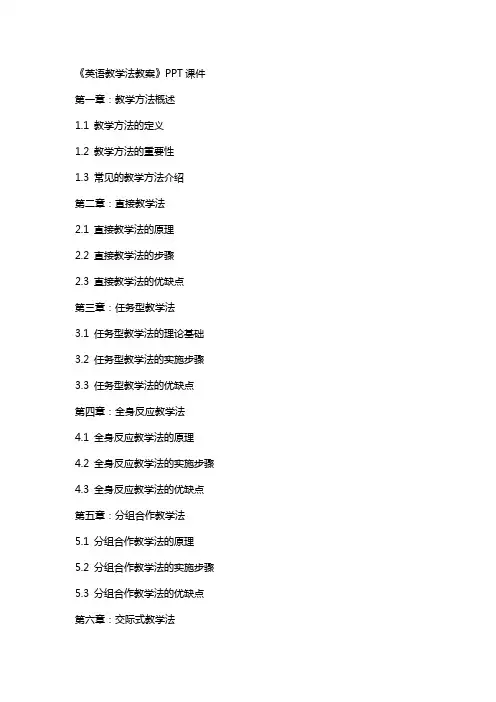
《英语教学法教案》PPT课件第一章:教学方法概述1.1 教学方法的定义1.2 教学方法的重要性1.3 常见的教学方法介绍第二章:直接教学法2.1 直接教学法的原理2.2 直接教学法的步骤2.3 直接教学法的优缺点第三章:任务型教学法3.1 任务型教学法的理论基础3.2 任务型教学法的实施步骤3.3 任务型教学法的优缺点第四章:全身反应教学法4.1 全身反应教学法的原理4.2 全身反应教学法的实施步骤4.3 全身反应教学法的优缺点第五章:分组合作教学法5.1 分组合作教学法的原理5.2 分组合作教学法的实施步骤5.3 分组合作教学法的优缺点第六章:交际式教学法6.1 交际式教学法的理论基础6.2 交际式教学法的实施步骤6.3 交际式教学法的优缺点第七章:沉默法7.1 沉默法的原理7.2 沉默法的实施步骤7.3 沉默法的优缺点第八章:计算机辅助教学法8.1 计算机辅助教学法的原理8.2 计算机辅助教学法的实施步骤8.3 计算机辅助教学法的优缺点第九章:游戏教学法9.1 游戏教学法的原理9.2 游戏教学法的实施步骤9.3 游戏教学法的优缺点第十章:评估与反馈10.1 教学评估的重要性10.2 常见的教学评估方法10.3 教学反馈的技巧重点和难点解析一、教学方法概述难点解析:理解不同教学方法之间的差异以及如何根据学生的需求和教学目标选择合适的教学方法。
二、直接教学法难点解析:实施直接教学法时,如何有效地使用目标语言进行教学,并引导学生通过实践和应用来掌握语言知识。
三、任务型教学法难点解析:设计具有实际意义的任务,以及如何评估学生在任务中的表现,确保任务的实施能够有效地促进语言学习。
四、全身反应教学法难点解析:如何通过身体动作和表情来促进语言的学习,以及如何平衡语言输入和输出。
五、分组合作教学法难点解析:如何合理分组,以及如何引导小组成员进行有效合作,确保每个学生都能在小组活动中积极参与和学习。
六、交际式教学法难点解析:如何在课堂中模拟真实的交际情境,以及如何评估学生在交际活动中的语言运用能力。
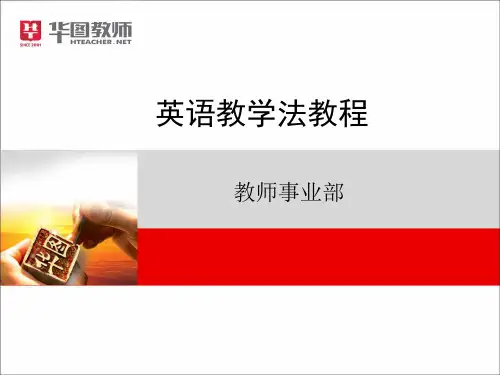
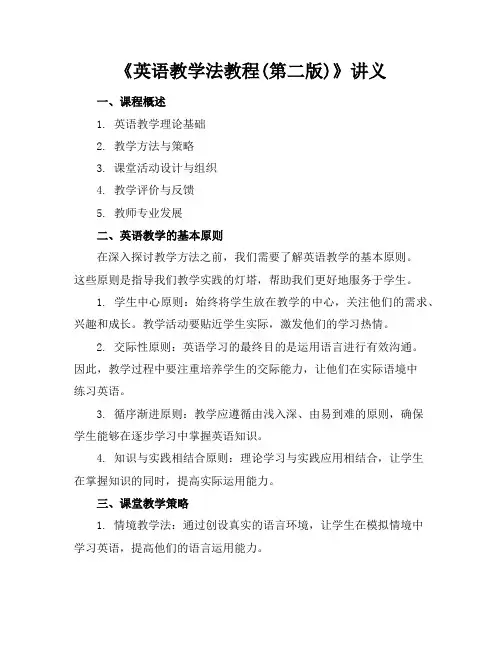
《英语教学法教程(第二版)》讲义一、课程概述1. 英语教学理论基础2. 教学方法与策略3. 课堂活动设计与组织4. 教学评价与反馈5. 教师专业发展二、英语教学的基本原则在深入探讨教学方法之前,我们需要了解英语教学的基本原则。
这些原则是指导我们教学实践的灯塔,帮助我们更好地服务于学生。
1. 学生中心原则:始终将学生放在教学的中心,关注他们的需求、兴趣和成长。
教学活动要贴近学生实际,激发他们的学习热情。
2. 交际性原则:英语学习的最终目的是运用语言进行有效沟通。
因此,教学过程中要注重培养学生的交际能力,让他们在实际语境中练习英语。
3. 循序渐进原则:教学应遵循由浅入深、由易到难的原则,确保学生能够在逐步学习中掌握英语知识。
4. 知识与实践相结合原则:理论学习与实践应用相结合,让学生在掌握知识的同时,提高实际运用能力。
三、课堂教学策略1. 情境教学法:通过创设真实的语言环境,让学生在模拟情境中学习英语,提高他们的语言运用能力。
2. 任务型教学法:以完成任务为目标,引导学生积极参与、合作探究,培养他们的团队协作能力和解决问题的能力。
3. 激励性评价:采用正面、鼓励性的评价方式,关注学生的进步和努力,激发他们的学习积极性。
4. 多元化教学手段:结合现代教育技术,运用多媒体、网络等资源,丰富教学手段,提高教学效果。
四、课堂活动实践2. 互动环节:设计小组讨论、角色扮演等活动,让学生在互动中提高英语听说能力。
3. 语言技能训练:针对听、说、读、写四个方面,设计专项训练活动,帮助学生全面提升英语能力。
通过本讲义的学习,希望您能在英语教学的道路上越走越远,为我国英语教育事业贡献自己的力量。
五、课程资源与材料的选择1. 教材选择:选用符合教学大纲、贴近学生实际、具有时代特色的教材。
同时,注意教材的难易程度,确保学生能够接受。
2. 辅助材料:充分利用网络资源、报刊杂志、影视作品等辅助材料,丰富教学内容,提高学生的学习兴趣。
Unit 15 Assessment in language Teaching 重要一、Understanding assessmentThe differences between testing, assessment and evaluation:1. Testing:It often takes the ‘pencil and paper’ form and it is usually done at the end of a learning period, such as unit-test, mid-term-test, semester-test etc.2. Assessment:It involves the collecting of information or evidence of a learner’s learning progress and achievement over a period of time for the purposes of improving teaching and learning.3. Evaluation:It involves making an overall judgment about one’s work or a whole school’s work. According to Cameron, it can be concerned with ‘a whole range of issues in and beyond language education: lessons, courses, programs, and skills can all be evaluated.’Evaluation is the most general of the three concepts, for decision-making purpose. Assessment focuses on the learning progress and process-oriented, for the purpose of improving teaching and learning. Test is one instrument of assessment, focusing on the result of learning.二、Assessment purposesAssessment in ELT means to discover what the learners know and can do at certain stage of the learning process.A close study of the assessment purposes will make it clear that all the people involved in education have some reasons to consider assessment necessary. They are administrators, teachers, parents and students.1. for administrators:They need to know whether the programs they have planned are working well. The only way to do this is to discover how well the students are doing with their courses.2. for teachers:Teachers put the administrators’ plans into practice. They need to know what has been done and what needs to be done next; what the students already know or can do and what they don’t know or can’t do yet.3. for parents:They are anxious to know what their children are doing in school. Unable to watch their kids in the class, parents value the feedback about their children’s performance from the teachers and the school.4. for students:They need to know what they’ve accomplished, be aware of what they need to work on next, and build up confidence and satisfaction from what they have achieved.三、Methods for assessmentAssessment includes testing but definitely not only testing. Assessment is often divided into summative assessment and formative assessment.1. Summative assessment:Summative assessment is mainly based on testing. It is done mostly at the end of a learning period or the end ofa school year.2. Formative assessment:Formative assessment is based on information collected in the classroom during the teaching process for the purposes of improving teaching and learning, therefore, it is sometimes termed as classroom assessment as well.3. The ways to gather students’ learning information:(1)Teacher’s observationsTeacher’s observations of the learners’ overall performance or achievement can be quite accurate and fair.(2)Continuous assessmentThe final grade given to the student is some kind of combination of the grades the student has received for various assignments during the course.(3)Self-assessment and peer assessmentStudents are able to make quite accurate assessment of their own achievements. With peer-assessment students are involved in assessing each other’s work.(4)Project workProject work requires students to complete a set of tasks designed to explore a certain idea or concept.(5)PortfoliosA portfolio is a purposeful collection of materials assembled over a period of time by a learner to provide evidence of skills, abilities and attitudes related to their study.四、Criteria for assessmentAssessment means to discover how well learners know things or can do things. Depending on different assessment purposes and the stage at which the assessment is made, assessment should be made according to different criteria or references.1. Different criteria or references of assessment:(1)Criterion-referenced assessmentCriterion-referenced language assessment is based on a fixed standard or a set criterion. The national or local educational authority may have this standard or criterion. A school or several schools in a district may have their standard or set criterion for whatever purposes they might have. A fixed standard is usually the ultimate goal which the students are expected to achieve at the end of the course.(2)Norm-referenced assessmentNorm-referenced assessment is designed to measure how the performance of a particular student or group of students compares with the performance of another student or group of students whose scores are given as the norm. A student’s achievement is therefore interpreted with reference to the achievement of other students or groups of students, rather than to an agreed criterion.(3)Individual-referenced assessmentIndividual-referenced assessment is based on how well the learner is performing relative to his or her own previous performance, or relative to an estimate of his or her individual ability. For example, if a student could only say a few words in English after a few months of the course, and now after another month’s study, he is able to speak with some fluency (although there is some inaccuracy), we can surely say he has made great progress.2. Criteria to assess portfolios:Setting up clear criteria for assessment is very important when introducing the use of portfolios.The criteria for assessing pupil’s portfolio:·Inclusion of all the required entries;·Quality of final products;·Seriousness of revisions;·Depth of reflections;·Layout and design;·Keeping to the time schedule.五、Assessment principlesAssessment should be based on the following principles:①assess authentic use of language in reading, writing, speaking, and listening;②assess literacy and language in a variety of contexts;③assess the environment, the instruction, and the students;④assess processes as well as products;⑤analyze patterns of errors in language and literacy;⑥base assessment on normal developmental patterns and behavior in language and literacy acquisition;⑦clarify and use standards when assessing reading, writing, and content knowledge;⑧involve students and parents, as well as other personnel in the assessment process;⑨make assessment an ongoing part of every day.It is ideal if assessors can follow all these principles. But in reality, it is very difficult to achieve this.六、Tests in assessment1. Drawbacks of using tests for assessment:①A test is often a one-off event which may not necessarily give a fair sample of the learner’s overall proficiency; They are not always valid or reliable;②Tests tend to fragment skills. Most tests test only lower-order thinking skills;③When assessment is solely dependent on test results, teachers tend to begin teaching to the test (washback effect).2. Types of test items:Test items can be designed in various formats. A test whose items are designed in different formats tends to have more validity and reliability than a test that is designed in a single format, for example, multiple-choice format. Below are the most frequently used test formats.(1)Questions & answersStudents are asked to answer questions according to information provided in reading texts or recorded materials. (2)True or false questionsStudents are provided with a set of statements related to the read or heard texts and required to decide whetherthey are true or false according to the texts.(3)Multiple-choice questionsThis form can be used virtually for all language areas, such as reading, listening, vocabulary, grammar, and pronunciation. Usually there are 3—5 choices, one of which is the correct answer, and the rest are distracters. (4)Gap-filling or completionStudents are asked to complete paragraphs or sentences by either filling in words they think are appropriate or choosing the best from the given choices. The test goals can be of grammar, vocabulary or reading comprehension.(5)Matching questionsTraditionally matching is only used for vocabulary tests, i.e. students are asked to match words with their definitions or their synonyms or antonyms. Now matching is used in a great variety of ways.(6)DictationStudents write down exactly what is read to them. The dictated materials can be sentences or short paragraphs. (7)TransformationUsually students are asked to transfer sentences from one pattern to another but keep the original meaning. A similar term for this form is rewriting.(8)TranslationStudents are asked to translate sentences or paragraphs from or into the target language.(9)Essay writingStudents are asked to write an essay on a certain given topic. Usually a set of instructions are given regarding the length, format and topic of the expected essay. Evaluation is based on both the language and the contents of the essay.(10)InterviewInterviews are often used to evaluate oral skills. The testers ask the students questions or ask them to perform some tasks.3. The role of testing in the classroom:Classroom testing is the topic of this handbook. Although the teacher is primarily concerned with teaching rather than testing, classroom tests play three important roles in the second-language program: they define course objectives, they stimulate student progress, and they evaluate class achievement.(1)Defining course objectives(2)Stimulating student progress(3)Evaluating class achievement4. Types of test: 学硕语言学真题里考过四种测试类型There are four basic types of language tests: aptitude tests, progress tests, achievement tests, and proficiency tests.(1) The aptitude test (能力倾向测试)The aptitude test is conceived as a prognostic measure that indicates whether a student is likely to learn a second language readily. It is generally given before the student begins language study, and may be used to select students for a language course or to place students in sections appropriate to their ability.(2) The progress test(进步测试)The progress test measures how much the student has learned in a specific course of instruction. The tests that the classroom teacher prepares for administration at the end of a unit or end of a semester are progress tests. Their format reflects the various components of the curriculum. This hand-book is written specifically to help teachers improve their progress tests and evaluate those which commercial publishers distribute to accompanytheir materials.(3) The achievement test(成绩测试)The achievement test is similar to the progress test in that it measures how much the student has learned in the course of second-language instruction. However, achievement tests are usually not built around one set of teaching materials hut are designed for use with students from a variety of different schools and programs. For example, the afternoon tests of the College Board battery are achievement tests. Dictations given over unfamiliar material may also he considered achievement tests when they are used to compare students across different programs.(4) The proficiency test(水平测试)The proficiency test also measures what students have learned, but the aim of the proficiency test is to determine whether this language ability corresponds to specific language requirements. The proficiency tests, in fact, usually report student language ability on a continuum that reflects a predetermined set of categories.(5) Diagnostic test (诊断测试)5. Testing items:When we design a test question, we should focus on the followings:validity(有效性),reliability(可靠性), discrimination(区别性), difficulty(难度), 具体掌握这几个的含义。
英语教学法教程课件英语教学法教程课件兴趣是最好的老师。
教学方法新颖又富有启发性,可激发学生的学习兴趣,使学生感到有趣、有味、有奇、有惑。
英语教学中,巧用情境教学法不失为一条锦囊妙计。
创设情境的方法很多,结合我多年来的教学实践,从课堂教学和课外教学两方面着手,总结如下:一、在课堂上创设情境1.利用实物,巧设情境教师通过实物演示情境能使学生边学习边体会所学知识,在实际生活中的应用,同时培养学生直接用英语思维的习惯。
如:教学“There be”句型、人体部位、方位词、形容词的比较等级都可用事物来演示教材内容。
再如,在讲授涉及问路的主题时,利用教室的课桌作为直观教具,有序排列,中间空出适当距离用做街道社区,然后让学生把课前自制的带有单位如school,hospital,toilet,the bus stop,the police station等的卡片放在课桌上,表示各建筑物所处的位置,形成某个建筑群的模拟情景,再让学生操练陌生人问路的对话。
在这种现实的“浓缩版”中,学生就能直观地理解向左转与向右转,并且懂得中西方在交通规则差异等方面的文化内容。
同时,学生的责任感、道德感与合作意识也得到了强化。
2.语言描述,引入情境充分利用教材中的课文创设问题情境。
教师可以向学生提出富有启发性的问题,制造悬念,创设问题情境,可以连珠炮式地提问,或者设置“突如其来的提问”,让学生就某个问题随便说说他们知道的东西。
让学生说出他们能想到的情况,如果说不出来,教师可以提示。
突如其来的提问可以使学习生动活泼,能引起学生临场发挥的冲动,获得成功感,增强学习的兴趣与信心。
例如:在讲解dangerous和careful时,课前我先安排一个学生,讲授时,我指着教室里的一只灯管“There is some thing wrong with the light.It doesn’t work.Who can mend it”?这时那位同学站起来说:“Don’tworry.I can mend it.”说完,他就走过来并假装去触摸灯管,这时我显出一种极为紧张的表情并大声说:“Becareful!It’s dangerous!”我一边在黑板上用红色粉笔画出“触电”标志符号,一边大声重复:“B ecareful!It’s dangerous!”这时再问同学们它们的含义,学生便能异口同声地说出来。